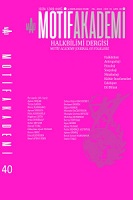TÜRK VE MOĞOL KÜLTÜRÜNÜN TARİHSEL PAYDASI: DOKUZ SAYISI
NUMBER NINE: THE HISTORICAL LEGACY OF TURKISH AND MONGOLIAN CULTURE
Author(s): Bilen YilmazSubject(s): Cultural history, Cultural Anthropology / Ethnology, Culture and social structure
Published by: Motif Halk Oyunları Eğitim ve Öğretim Vakfı
Keywords: Number nine; motif; common theme; Turkish and Mongol history; Central Asia;
Summary/Abstract: It is seen that Turks and Mongols, who have a unity of fate for hundreds of years, share many common motifs regarding both state tradition and social life. The number nine is an important symbol that stands out among the common cultural themes of the two nations. The first information about the number nine is mentioned in the Altai creation myths. It has been determined that there are plenty of references to the number nine in the epic narratives that also emphasize the common ancestry and connect Oguz Khan and Genghis Khan on one occasion. It is understood that Turks and Mongols, who direct the flow of world history, especially in Central Asia, carried the motifs of their ancient cultures into the belief systems they were involved in over time. As a matter of fact, the number nine was carried into the Sufi culture, which developed intensively in the Turkestan region, and showed itself in the literary products given. There are many sources that the Mongols, whose history was almost rewritten with Genghis Khan, used the number nine as a symbol of holiness. In these works, it is seen that the number nine, which is mostly identified with Genghis Khan, is also used in reference to Tamerlane in the sources belonging to the Timurid period. It is understood that the same attitude was followed in the literary and historical sources that emerged with similar writing traditions. In this article, we have examined the use of the number nine, which stands out as a reflection of faith-based partnership and has the characteristics of a cultural motif, although it is symbolic, in mythological, literary and historical sources, on the condition that it is limited to Central Asia and its immediate surroundings.
Journal: Motif Akademi Halkbilimi Dergisi
- Issue Year: 15/2022
- Issue No: 40
- Page Range: 1410-1425
- Page Count: 16
- Language: Turkish

